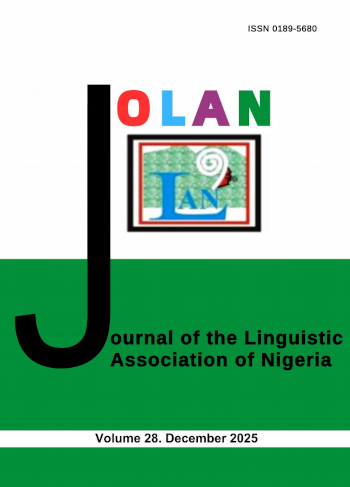The consonant system of Alege
Keywords:
Alege Language, Consonant System, Phonetic Analysis, Phonemic AnalysisAbstract
Alege is a minority Bendi language spoken in Alege community in Cross River State, Nigeria. Hitherto, the language remains largely undescribed. This study therefore examines the consonant system of the language. The goal is to provide an adequate description of the distinctive consonant inventory that will be useful in designing an orthography for the language. Data for this study were gathered through series of fieldwork undertaken between 2016 and 2019 in the community. The study adopts a descriptive approach for the analysis of both phonetic and phonemic data. For instrumental analysis, a palatography test is used to interpret phonetic data while the Phonology Assistance is employed for phonemic analysis. In addition, the study also adopts the classical phonemics method in determining the phonemic status of consonants in the language. Based on the findings, thirty-seven (37) phonetic consonants were identified. Using the principle of contrast, twenty-nine (29) phonemes were established in the language. Although a phoneme, the voiced labiodental fricative /v/ it has very limited occurrence in the language. The voiced bilabial fricative [β] is considered a social variant of the voiced bilabial stop [b] since it is conditioned by the age of the speaker. The voiced bilabial and voiced alveolar nasals /m n/ are the only consonants permitted as codas in the language. Homorganic nasal assimilation and labialization are some of the prevalent features of the consonant system of the language.
References
Ayugha, K.E. (2011). Reading Bokyi without tears. Unpublished Language primer.
Ayugha, K.E. (2013). A grammatical sketch of Utugwang. Unpublised Research Project. The Theological College of Northern Nigeria, Jos.
Bamgbose, A. (1967). Notes on the phonology of Mbe. Journal of West African Languages, 4. 5–11
Blench, R.M. (2001). The Bendi languages: lost Bantoid languages? Paper presented at the 32nd Annual Conference on African Linguistics: Benue-Congo Workshop Berkeley, March
Clark, J. & Colin, Y. (2006). An introduction to phonetics and phonology. Malden MA: Blackwell Publishing.
Crozier, D. and Blench, R.M. (1992). Index of Nigerian Languages (edition 2). SIL, Dallas.
Davenport and Hannahs (2010) Introducing phonetics and phonology. London: Arnold.
Hockett, C. (1942). A system of descriptive phonology. Language, 18, 3-21.
Hyman, L.M. (1975). Phonology: theory and analysis. New York: Holt, Rinehart and Winston.
McCarthy, J.(1994). The phonetics and phonology of Semitic pharyngeals. In P. Keating (ed). Papers in laboratory phonology III. Cambridge: Cambridge University Press.
Otronyi, L., Ajaegbu, G., Hon, L., Muniru, J., & Nweke, U. (2013). A summary report of a sociolinguistic survey of the Alege language of Cross River State, Nigeria. SIL Publication.
Pike, K.I. (1947). Phonemics: a technique for reducing languages to writing. Ann Arbor: University of Michigan Press. Snider, Keith and James Roberts. 2004. SIL comparative African word list (SILCAWL). Journal of West African Languages 31(2):73-122
Yul-Ifode, S. (1999). A Course in Phonology. Port Harcourt: River Side Communications.














